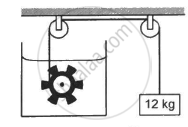Advertisements
Advertisements
प्रश्न
A calorimeter has mass 100 g and specific heat 0.1 kcal/ kg °C. It contains 250 gm of liquid at 30°C having specific heat of 0.4 kcal/kg °C. If we drop a piece of ice of mass 10 g at 0°C, What will be the temperature of the mixture?
उत्तर
Let the final temperature of the mixture be T.
Amount of heat required in converting 10 g ice to 0°C to water at 0°C = 10 × 80 = 800 cal
Total amount of heat required in converting 10 g water to 0°C to water at T°C = 10 × 1 × T = 10T
Total heat energy required to convert 10 g ice at 0°C to water at T°C = 800 + 10T
Amount of heat released to raise the temperature of calorimeter at 30°C to T°C = 100 × 0.1 × (30 - T) = 10(30 - T)
Amount of heat released to raise the temperature of 250g of eater at 30°C to T°C = 250 × 0.4 × (30 - T) = 100(30 - T)
Total amount of heat released in the process = 110(30 - T)
Using the principle of calorimeter, we have
110(30 - T) = 800 + 10T
APPEARS IN
संबंधित प्रश्न
A geyser heats water flowing at the rate of 3.0 litres per minute from 27 °C to 77 °C. If the geyser operates on a gas burner, what is the rate of consumption of the fuel if its heat of combustion is 4.0 × 104 J/g?
A copper vessel of mass 100 g contains 150 g of water at 50°C. How much ice is needed to cool it to 5°C?
Given: Specific heat capacity of copper = 0.4 Jg-1 °C-1
The Specific heat capacity of water = 4.2 Jg-1 °C-1
The Specific latent heat of fusion ice = 336 Jg-1
Write the approximate value of specific heat capacity of water in S.I. unit.
What do you mean by the following statement?
The heat capacity of a body is 50 JK-1?
Give one example where high specific heat capacity of water is used as cooling purposes?
State three ways to minimize the global warming.
What is carbon tax?
Figure shows a paddle wheel coupled to a mass of 12 kg through fixed frictionless pulleys. The paddle is immersed in a liquid of heat capacity 4200 J K−1 kept in an adiabatic container. Consider a time interval in which the 12 kg block falls slowly through 70 cm. (a) How much heat is given to the liquid? (b) How much work is done on the liquid? (c) Calculate the rise in the temperature of the liquid neglecting the heat capacity of the container and the paddle.

Write two advantages of high specific heat capacity of water.
Write the approximate values of the specific latent heat of fusion of ice.
1 kg of water freezes to form ice at 0°C. What amount of heat is withdrawn?
Derive an expression for finding out the specific heat capacity of a body (solid) from the readings of an experiment given below:
(i) Mass of empty calorimeter (with stirrer) = m1 gm
(ii) Mass of the metal piece = M gm
(iii) Mass of colorimeter and water = m2 gm
(iv) Initial temperature and water = t1°C
(v) Temperature of hot solid (metal piece) = t2 °C
(vi) Final temperature of the mixture = t°C
(vii) Specific heat of calorimeter = 0.4 J gm / °C
If 'f' is the number of degrees of freedom of a molecule of a gas and ratio of molar specific heats of a gas, ϒ = 1 + `2/"f"` where ϒ = Cp/Cv. The ratio of 'ϒ' for monoatomic gas to 'ϒ' for (rigid) f diatomic gas is ______.
On supplying 100 µC of charge to a conductor, its potential rises by 5 V then capacity of the conductor is ______.
Two cylinders of equal height and radius are made of copper and aluminum. Which of them conducts heat faster?
Which of the following substances (A, B and C) has the highest specific heat?

We would like to make a vessel whose volume does not change with temperature (take a hint from the problem above). We can use brass and iron `(β_(vbrass) = (6 xx 10^(–5))/K and β_(viron) = (3.55 xx 10^(–5))/K)` to create a volume of 100 cc. How do you think you can achieve this.
The specific heat capacity of ______ is maximum.
The molar specific heats of an ideal gas at constant pressure and volume are denoted by Cp and Cv, respectively. If `gamma = "C"_"p"/"C"_"v"` and R is the universal gas constant, then Cv is equal to ______.
Calculate the amount of heat energy required to raise the temperature of 200 g of copper from 20°C to 70°C. Specific heat capacity of copper = 390 J kg-1 K-1.
